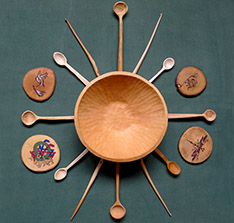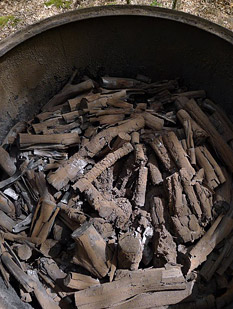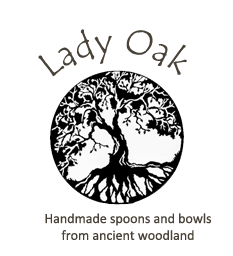



August 11th is Saint Alexander's day, but who is Saint Alexander, you may ask? Well, he is the patron saint of charcoal burners. These are the folk who the rural communities of England dubbed as “The Devil’s People”. This name was given to them mainly due to their blackened appearance, from working with the charcoal, but also because they were itinerant workers who travelled around the country from one woodland site to another, performing their alchemy on wood. Their way of life caused suspicion and fear within the rural communities who viewed the charcoal burner’s craft as ‘magic’. It may be that the legendary Wayland the Smith, the master blacksmith in Germanic and Norse mythology, would have been a more appropriate deity to represent the Charcoal Burners, for it would have been the blacksmiths who benefited most from their mysterious craft.
In earlier times charcoal was much in demand and the life of a charcoal burner would have been one of hard work and long, irregular hours. Back then, there would have been no steel kilns, as there are now, and all the magic would have taken place in earth kilns. These kilns would have to have been rebuilt for each new burn and they were, at best, temperamental and slow.
The process of converting wood into charcoal involves setting fire to the wood, then controlling the rate at which it burns until, eventually, all the moisture is driven out of the wood. Firstly, the kiln is built and the wood stacked inside. The wood is then set alight and, once it is burning well, the flue is sealed to restrict the flow of oxygen to the fire (if this were not done the fire would continue to burn unchecked). The kiln must be watched constantly to ensure that the fire does not go out and that there are no signs of the structure collapsing. From time to time small holes are opened to allow air to enter in a controlled manner. A lazy blue smoke coming from the chimney is the sign that all the moisture has been driven out and the wood is beginning to burn away into ash. It is at this point that the kiln must be completely starved of oxygen so that the wood ceases to burn. It is then left to cool down until it is at a temperature where it can be handled, which normally takes around 3 days. The kiln is then opened and the charcoal can be sorted and graded.There is still a large demand for charcoal in this country, almost exclusively for the BBQ market, but currently 95% of this charcoal is imported. This imported charcoal comes from the rain forests of South East Asia, Africa and South America, and unfortunately some of it is taken from non-sustainable wood sources and also from illegal logging. The FSC accreditation has gone gone a long way to addressing the problem of where a tree is sourced from, but the FSC does favor the larger commercial producer where the costs of accreditation can more readily be absorbed into the business. A common trick, seen with imported charcoal used to be the addition of cement dust to the bag. This boosts the weight of the product by adding to the yields per burn. The evidence that cement dust has been added to the charcoal is shown by the large amount of unusually white ash that is left after it has been burnt.
The benefits of British charcoal are that the wood is sourced from a sustainable system of woodland management. This system of management, called coppicing, has been utilized in Britain for several thousand years. Possibly the oldest evidence for the use of coppiced wood is from the Sweet Track in Somerset, built from coppiced Lime circa 3806-3807 BC. However, the last time any large-scale coppice was cut in this country was during World War II, when there were extreme fuel and building material shortages. It is important to buy local charcoal as this will support the reinstatement of the coppice regime and protect the habitat of all the flora and fauna that depend upon these woodlands for their existence. It is worth noting that British charcoal lights a lot more easily and gets up to cooking temperature more quickly too. This means that there is less need to use lighting fluids and gels and, more importantly, you do not have to wait so long for your food! Also, a number of top chefs say that British charcoal imparts a more pleasing flavour to the food that gas barbeque's cannot, so it makes sense to buy local produce.
Since early times charcoal has been used for a variety of purposes including craftwork, medicine, art and in industry. Listed below are some of the applications:
Here at LadyOak we produce BBQ charcoal. If you would like to get hold of a bag come and see us at one of the farmers markets we attend.



